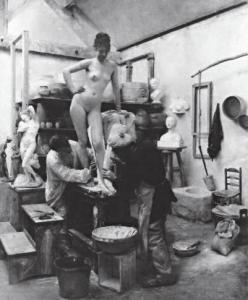H. de Roos - Rodinīs Approach to Art |
|
|
To Gsell, Rodin himself explains the difference between a surmoulage, a life plaster cast of the model, and his own approach as follows: "Nevertheless,", I*
answered with some malice, "it is not nature exactly as it is that
you evoke in your work." (...) |
Edouard Dantan, Surmoulage sur nature, |
|
"Look!" he said to me;
"I have accented the swelling of the muscles which express distress.
Here, here, there - I have exaggerated the straining of the tendons which
indicate the outburst of prayer."
In Rodinīs eyes, the artist produces no wilful distortion, adds no deliberate emphasis or exaggeration: it is Nature himself that guides the perception and the feeling of the talented artist. His expression is not subjective, arbitrary, but based on the laws of geometry: If someone comes and praises my symbolism, my power of expression, still I know that the only important thing are the surfaces. Respect the surfaces, depict them correctly from every side, and movement will come; shift the masses, and create a new equilibrium. The human body can be compared to a striding temple; and like a temple, it has a center of gravity around which the volumes of the body are distributed and ordered. Once you have realized this, you know everything. It is simple, but you have to see it. Academic artists don't want to see it. Instead of realizing that this is the key to my method, people call me a poet... They say my sculpture is the sculpture of an enthusiast. I do not deny that it contains much of a violent nature, but this overwrought quality does not come out of me, it is a part of nature itself and its motion. The works of God are by their very nature exaggerated; I am only true to them. Nor is my temperament overexcited; it is tranquil. Nor am I a dreamer, but a mathematician, and if my work is good, then it is because it's geometric...
In these statements, the two contradictory principles in Rodinīs approach to Art both are worded: the romantic, emotional, expressive tendency on the one hand, the rational, geometric principle, stressing balance and proportion, on the other. Karl Schilling, who analysed Rodinīs theory on Art in his 1938 thesis, concluded that its is the underhand struggle between these two directions that constitutes the highly individual quality of Rodinīs work.
|
|
|
|
|
|
Notice:
Museum logos appear only as buttons linking to Museum Websites and do not
imply any |
|
